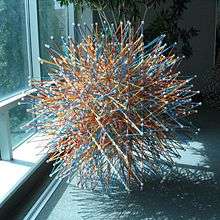Construction set




A construction set is a set of standardized pieces that allow for the construction of a variety of different models. The pieces avoid the lead-time of manufacturing custom pieces, and of requiring special training or design time to construct complex systems. This makes them suitable for temporary structures, or for use as children's toys.
Categories
Construction sets can be categorized according to their connection method and geometry:
- Struts of varying length that are connected by nodes are good for building space frames, and often have components that allow full rotational freedom.
- D8h (*228) nodes are used for K'Nex, Tinkertoys, Playskool Pipeworks, Cleversticks
- Ih (*532) nodes are used for Zometool
Spherical magnets
- Panels of varying sizes and shapes
- Panels of varying sizes and shapes are connected by pins or screws perpendicular to the panels, which are good for building linkages such as an Erector Set, Meccano, Merkur, Steel Tec, Lego Technic, Trix, FAC-System and Überstix
- Panels of varying sizes and shapes with flexible panels or hinges between panels such as Tog'l, Jovo Click 'N Construct, Zaks, and Polydron.
- Struts and panels
- Synestructics (does not make pentagonal structures).
- Geomag (components are magnetic).
- Building components with various methods of connection include:
- No connection: toy blocks, Anchor Stone Blocks, KEVA planks, Kapla and Unit Bricks
- Studs: Rokenbok, Lego, Coco, Rasti, Tente, Mega Bloks, Fischertechnik, Playmobil, Loc Blocs, Cobi blocks, Betta Builda and Oxford, Kre-O
- Notches: Lincoln Logs, GIK, and Stickle bricks
- Sleeves: Capsela
Psychological benefits
Construction toy play is beneficial for building social skills and building trust in others because it acts as a collaborative task where individuals have to cooperate in order to finish the task — building an object out of Lego, for example. The effect was found in high school students.[1]
For children specifically, children who complete models using toy building blocks have much better spatial ability than children who do not complete such models. Spatial ability also predicts completion of models.[2]
Construction toy play is also beneficial for autistic children when both individual and group play with building blocks is incorporated. Autistic children who played with building blocks were motivated to initiate social contact with children their age, they were able to maintain and endure contact with those children, and autistic children were also able to surpass the barriers of being withdrawn and being highly structured.[3]
Influence on Architecture
Renowned architect Frank Lloyd Wright credited his childhood building blocks designed by Friedrich Fröbel as a major influence, and his son John Lloyd Wright created the widely known Lincoln Logs building set.[4] In addition to teaching architectural concepts such as modularity and load-bearing construction,[5] many architects credit construction set play as influencing their later design.[4]
See also
References
- ↑ Kato, D.; Hattori, K.; Iwai, S.; Morita, M. (2012). "Effects of collaborative expression using LEGO® blocks, on social skills and trust". Social Behavior and Personality. 40 (7): 1195–1200. doi:10.2224/sbp.2012.40.7.1195.
- ↑ Brosnan, M. J. (1998). "Spatial ability in children's play with Lego blocks". Perceptual and Motor Skills. 87 (1): 19–28. doi:10.2466/pms.1998.87.1.19.
- ↑ LeGoff, D. B. (2004). "Use of LEGO© as a Therapeutic Medium for Improving Social Competence". Journal of Autism and Developmental Disorders. 34 (5): 557–571. doi:10.1007/s10803-004-2550-0.
- 1 2 Heathcote, Edwin (9 August 2013). "Toytown and the city". Financial Times. The Financial Times Limited. Retrieved 17 December 2013.
- ↑ Stewart, Matt (12 June 2013). "Modern toys curb creativity – academics". Stuff.co.nz. Fairfax New Zealand Limited. Retrieved 17 December 2013.